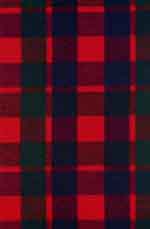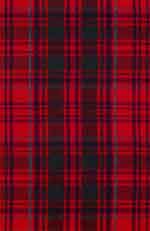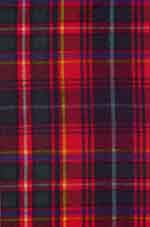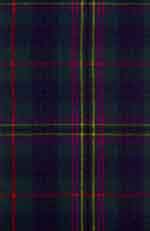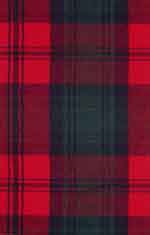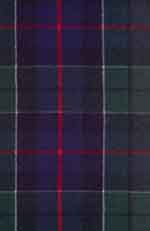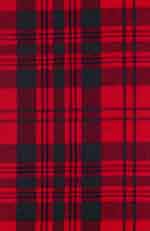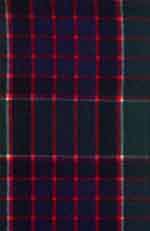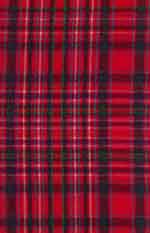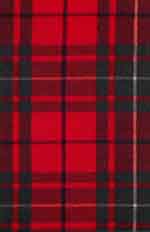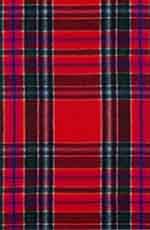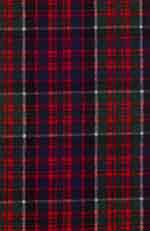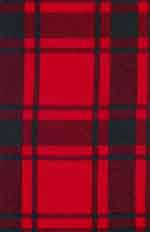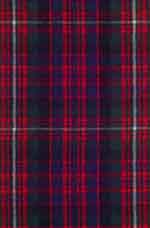|
Scottish Clans and Tartans Part 1: Clans ANDERSON - FRASER of LOVAT This page: Clans GORDON - MacDONELL of GLENGARRY
It was in the 14th ct. that the Gordons came from the Lowlands to Aberdeenshire. At this time Sir Adam, Lord of Gordon, was granted lands in Strathbogie by Robert the Bruce. Elizabeth, the daughter of a descendant, married Alexander Seton who assumed the Gordon name. Their son was created Earl of Huntly in 1449. The 6th Earl of Huntly got a marquessate in 1599, and the 4th Marquess became Duke of Huntly by Charles II. in 1684. As the 5th Duke didn´t have any heirs the titles died with him, the marquessate going to the Earl of Aboyne and the estates to the Duke of Richmond who, in 1876, was created Duke of Gordon. The Methlic branch of the Gordons acquired lands in Haddo in 1533. A well-known member of this family was Sir John who was created a baronet of Nova Scotia by Charles I. in 1642. His son, Sir George, was President of the Court in Session and received the earldom of Aberdeen in 1682. The Kirkcudbright branch of the Gordons were descended from the original Border Gordons and acquired lands in Lochinvar and Kenmure in the 14th ct. In 1633 Sir John Gordon was created Viscount Kenmure and Lord Lochinvar. The members of that branch were strong supporters of the Stuarts. The 6th Viscount was executed after the 1715 Rising, and his estates forfeited. The famous Gordon Highlanders Regiment was founded in 1794, with the assistance of Jane, Duchess of Gordon.
The name "Gow" is derived from the Gaelic word "Gobha" meaning a blacksmith or armourer, but it may be a shortening of "MacGowan" meaning son of the smith. As smiths were essential clan members these names are associated with several clans but the main Highland branch is believed to be connected with the MacPhersons and Clan Chattan. This connection is based on a clan conflict which took place on the North Inch of Perth in 1396 when Henry Wynd, the so-called "crooked smith", took part on behalf of one of the clans involved. Although the Gows are scattered throughout Scotland (Stirling, Glasgow, Fife, Dumfries and the Lowlands) they can be chiefly found in Perthshire and Inverness-shire. Two famous clan members were Neil Gow (1727-1807), a notable reel composer and "prince of the Scottish fiddlers" and his also celebrated son Nathaniel Gow (1766-1831). As a supporter of the Jacobites a John Gow had to took refuge in Glenlivet after the 1745 Rising. He changed his name into Smith and started making the whisky which is so famous today.
Tradition has it that it was the Grahams who breaches the Roman Wall across Scotland, and from this incident was named "Graeme´s Dyke". Whether this happened or not, the Grahams are nevertheless a very ancient family and their origin dates back before the 12th ct. The first recorded Graham was William de Graham who received the lands of Abercorn and Dalkeith from David I. Sir John Graham of Dundaff, the right hand of William Wallace, was killed in the Battle of Falkirk in 1298. The 3rd Lord Graham was created Earl of Montrose by James IV. in 1504 and fell at Flodden on Sept. 9th, 1513. James Graham, 5th Earl, was created Marquis of Montrose in 1644. He was a brilliant soldier, and his campaign in Scotland one of the masterly in military annals. He was executed in Edinburgh in 1650. James, 4th Marquis, was elevated in 1707 to the dukedom of Montrose. Another famous soldier of the Montrose family was John Graham of Claverhouse, Viscount Dundee. During his campaign against the Covenanters he gained the nick-name "Bloody Clavers" but his friends and supporters he was "Bonnie Dundee". He died in his hour of thriumph at the Battle of Killiecrankie in 1689.
The Clan Grant claims to be descended from Kenneth MacAlpine, the 9th ct. king of Scotland. In the 13th ct. the Grants were Sheriffs of Inverness exerting considerably influence throughout the north-east and supporting William Wallce. John Grant, the clan chief, married the daughter of Gilbert of Glencairnie, and from his elder son sprang the Grants of Freuchie. His younger son was the progenitor of the Tullochgorm branch. From John Grant of Freuchie are descended the Earls of Seafield, the Grants of Corrimony and the Grants of Glenmoriston. The Grants always were royalists and in 1690 took part in the Battle of the Haughs of Cromdale which gave its name to the famous pipe tune. In the Jacobite Risings the clan except the Grants of Glenmoriston were supporting the Hanoverian side.
The original territory of the Clan Gunn was Caithness and Sutherland. They claim to descend from Olave the Black, the Norse king of Man and the Isles, who died in 1237. True to their name, which means "battle", the clan was noted for its warlike and ferocious character and continued to entend its possessions until the 15th ct. but continual feuds with other clans led to its settling, chiefly in Sutherland. George Gunn, one clan chief, held the office of Crowner in the 15th ct. He lived in magnificient style in his castle at Clyth, but was killed by treachery in 1464 when endeavouring to end the feud and arrange a reconciliation with the Clan Keith. His death was revenged a century later by his grandson, who killed Keith of Ackergill, his son and twelve followers at Drummoy in Sutherland. Feuds continued between the Gunns and the MacKays, and the Earls of Caithness and Sutherland. The Earls attacked the Gunns in 1585 who, although fewer in numbers, held the advantage of position on higher ground. They killed 140 of their enemies, and only darkness prevented a great slaughter. The Gunns, however, were defeated later at Lochbroom by the Earl of Sutherland.
The name probably came from Leicestershire in England. The first record in Scotland is claimed for Walter Fitz-Gilbert from whom are descended the Dukes of Hamilton. Walter witnessed a charter in 1294 conferring on the monastery of Paisley the privilege of herring fishing in the Clyde. He was Govenor of Bothwell Castle for the English during part of the Scottish war of Independence, but later joined Robert the Bruce from whom he received the Barony of Cadzow. James, 6th Baron of Cadzow, was created Lord Hamilton in 1445 and married Princess Mary, the eldest daughter of James II. and widow of the Earl of Arran. James Hamilton, his son, was created Earl of Arran in 1503 and Duke of Chatelherault in France in 1549. His second son was created Marquis of Hamilton in 1599, and his forth son was the ancestor of the Earls of Abercorn. James, 3rd Marquis, was created Duke of Hamilton in 1643. William, 2nd Duke, died from wounds received at the Battle of Worcester in 1651 and was succeeded by his niece Anne, Duchess of Hamilton, who married Lord William Douglas, through whom the Hamilton titles passed to the Douglases.
The Hays descend from William de la Haye who came to Scotland about 1160, married a Celtic heiress and received the lands of Erroll from William the Lion about 1180. His grandson Gilbert, 3rd Baron of Erroll, was co-Regent of Scotland. Sir Gilbert, 5th chief, was one of the heroes of the Scottish War of Independence. He was given Slains Castle in Buchan and made hereditary Constable of Scotland by Robert the Bruce. Thomas, 7th chief, married the daughter of King Robert II, and William, 9th chief, became Earl of Erroll in 1452. William, 4th Earl, fell at Flodden with 87 Hays. Francis, 9th Earl, in alliance with Huntly defeated Argyll at Glenlivet in 1594, but James VI. personally blew up Slains Castle because the Earl was plotting with his Spanish enemies. A new castle was built a few miles farther north in 1664. In 1627, Sir George Hay was made Viscount Dupplin and Lord Hay of Kingauns, and in 1633 was created Earl of Kinnoul. The 9th and 10th Earls of Kinnoul successively held the office of Lord Lyon from 1796 until 1866. John Hay of Restalrigg was a close companion of the Old Pretender in exile and was created Earl and then Duke of Inverness in the Jacobite peerage.
The name Henderson, in Gaelic Mac Eanruig, is found in widely separated districts of Scotland. Those in Caithness claim to be a sept of Clan Gunn. The principal family of Henderson was the Clan Eanruig of Glencoe from whom it is claimed that they lived in that glen centuries before the MacDonalds arrived there. Tradition states that Iain Fraoch, brother of John, 1st Lord of the Isles, married a daughter of the chief of the Hendersons of Glencoe and that their son Iain Abrach was the founder of the MacIains of Glencoe. Since then the clan was also known as Clan Abrach. The Hendersons, who were always notable for their strength, formed the bodyguard of the chief and were the hereditary pipers of the Clan Abrach. From the Hendersons of Fordell in Angus was descended the Reverend Alexander Henderson, who was prominent in the Presbyterian Church of Scotland during the early 17th ct. He helped to prepare the National Convent of 1638 and was Moderator of the Glasgow Assembly which outlined the Presbyterian organisation in the same year. He drafted the Solemn League and Covenant in 1643 and was member of the Westminster Assembly which issued the Confession of Faith.
This clan is of ancient origin and is found in the province of Moray as early as the 12th ct. when Berowald, the Flemish, received a charter of the lands o9f Innes from Malcolm IV. in 1160. His grandson assumed the name Innes from his lands and got the confirmation of his charter from King Alexander II. in 1226. By marriage, Sir Alexander, 9th chief, acquired the lands of Aberchirder in the 14th ct. and from now on branches of the family established themselves all over the north of Scotland. Alexander, 13th chief, managed to increase his possessions between 1493 and 1533, and Robert, 20th chief, was created a baronet in 1625. In 1767, Sir James, 6th Baronet sold the lands of Innes to the Earl of Fife and went to reside in England, but on the death of the 4th Duke of Royburghe, as heir-genera he claimed the Scottish titles and estates of that family and got all that. He assumed the name Ker and succeeded as 5th Duke of Roxburghe. James, 6th Duke, was created Earl Innes in 1836.
The Johnstons were a powerful clan who derived their name from the barony of Johnston in Annandale. The name occurs in records of the 13th ct., and from that time onward they were always prominent in Border warfare. They supported the Crown for generations, and in 1633 Sir James Johnston of Johnston was created Lord Johnston of Lochwood by Charles I. and ten years later Earl of Hartfell. John Johnston, a member of the Johnstons of Westerhall in Dumfriesshire, was created a Baronet of Nova Scotia in 1700. The Johnstons of the north claim descent from Stiven de Johnston who lived in the 14th ct. and whose grandson possessed the lands of Ballindalloch. George Johnston of Ballindalloch was created a Baronet of Nova Scotia in 1626. Sir John, 3rd Baronet, was unjustly executed in London in 1690 for being present at the marriage of Captain Campbell of Mamore who was alleged to have abducted Miss Wharton and married her. Campbell escaped to Scotland but Johnston was betrayed by his landlord for 50 pounds. Sir John, 4th Baronet, was out for the Jacobites in the 1745 Rising, and his son was killed at Sheriffmuir.
One of the most powerful Celtic families, the Keiths held the office of Great Marischal from the 12th ct. In the 14th ct. they took possession, through marriage, of lands in Caithness, and for a long time their settlement there was a source of feuds with Clan Gunn. An attempt of reconsiliation being unsuccessful, a meeting was arranged between 12 horseman from both sides. The Keiths arrived with two men on each horse and attacked the Gunns while they prayed. Both sides fought with desperation until most of the Gunns were killed, including their chief, and the Keiths retired considerably depleted. The surviving Gunns later followed and killed many of the remaining Keiths. Sir William Keith was created Earl Marischal by James II. in 1458, and the family stayed a very powerful one for the next centuries. George, 5th Earl Marischal, founded the Marischal College in Aberdeen. James, the younger son of the 9th Marischal, and brother of the 10th, was a notable soldier, who fought for the rebels in the 1715 Rising. In 1728 he joined the Russian army and became a General in 1737. In 1747 he joined the German army and was made a Field-Marshal by Frederick the Great. On the death of George, last Earl Marischal, in 1778, the entailed estates passed to Lord Falconer, and the remainder of his property was divided among his grand-nephews.
This ancient clan, whose name means "ugly head", is found associated with the southwest of Scotland from the 12th ct., and the history of the Carrick district in Ayrshire is substantially the early history of the Kennedys. They are claimed to have descended from the 1st Earl of Carrick. The Kennedys of Dunure acquired Cassilis, and later one of the family married Mary, daughter of Robert III. Their son was created Lord Kennedy in 1457, and in 1509 the 3rd Lord was created Earl of Cassilis. Gilbert, 4th Earl, earned an infamous reputation for his dreadful deed of "roasting the Abbot of Crossraguel" in the black vault of Dunure Castle to obtain possession of the lands of the Abbey. The 6th Earl raised a regiment which suffered heavily in the defeats of Alford and Kilsyth in the Covenanter War. Archibald, 12th Earl, was created Baron Ailsa in 1806, and in 1831 Marquess of Ailsa. The 9th and 10th Earls were the builder of Culzean Castle between 1775 and 1790. Tradition tells that Ulric Kennedy fled from Ayrshire for some lawless deed and settled in Lochaber where his descendants were known as Clan Ulric. The Kennedys of Skye and other Highland districts trace their origin from this family branch. The Lochaber branch joined forces with the Camerons and are expected as a sept of that clan.
The Kerrs are of Anglo-Norman origin, descended from two brothers who settled in Roxburgh in the 14th ct., although the name may have existed in the 12th ct, and it is also claimed that the name comes from a Celtic word meaning strength. The Kerrs of Cessford were Wardens of the Marches and prominent in Border conflicts. They were granted old Roxburghe by James IV. and Sir Walter Cessford fought on the side of James VI. and Mary Stuart at Langside in 1568. Sir Robert, born in 1570, was created Lord Roxburghe in 1600, and in 1616 received the earldom of Roxburghe. By marriage with the Earl´s daughter Jean, Sir William Drummond became 2nd Earl of Roxburghe and assumed the name Kerr. John, 5th Earl, supported the Union of 1707 and was created Duke of Roxburghe. The direct line failed on the death of the 3rd Duke and Lord Bellenden became the 4th Duke but he also had no children. After a long and confusing contest Sir James Innes succeeded as 5th Duke and assumed the name Kerr. In 1606 Mark Kerr of Newbattle was created Earl of Lothian. His son Robert, 2nd Earl, had no male descendant, and the title passed through his daughter to her husband, William Kerr, son of the 1st Earl of Ancrum, who became 3rd Earl of Lothian in 1631. Robert, 4th Earl, was raised to the marquessate of Lothian in 1701.
The Norse name of this ancient clan who held considerable lands in Argyll means "law-giver". In the early 13th ct. Laumun granted certain lands at Kilmun and Kilfinan to the monks of Paisley, and in 1456 John Lamont was Bailie of Cowal. John Lamont of Inveryne was knighted in 1539 and received the Barony of Inveryne. At this time his principal seat was at Toward Castle, where he entertained Mary Queen of Scots in 1563. During the Civil War several of the Campbell chiefs ravaged the Lamont territory with fire and sword, destroying the castles Toward and Ascog, and in 1646 treacherously massacred 200 Lamonts at Dunoon. This massacre formed one of the charges against the Marquess of Argyll, for which he was executed in 1661. After the devastation of Toward Castle Ardlamont became the principal seat of the chief. John, 19th chief, commanded the Gordon Highlanders at Corunna in 1809. The Lamonts of Knockdow are one of the oldest cadet families and the only one still possessing the old clan lands.
The family takes its name from the lands of Leslie in Aberdeenshire. In the 12th ct. Bartholomew, a Flemish aristocrate, obtained the Barony of Lesly, and from him are descended the Earls of Rothes, the title being conferred on George de Lesly of Rothes. His grandson George, 2nd Earl, was killed at Flodden in 1513. The Leslies were concerned in the murder of Cardinal Beaton in St. Andrews, and George, 4th Earl, was tried for his part but acquitted. Andrew, 5th Earl, who succeeded his father in 1588, was a supporter of Mary Queen of Scots and his successor John a prominent leader of the Covenanters. John, 7th Earl, was created Duke of Rothes in 1680 but his dukedom died with him while the earldom continued through his daughter. General Alexander Leslie of the Balgonie family served under the Swedish King Gustav Adolph and became Field-Marshal. Later he went back to Scotland to command the Covenanters and captured Edinburgh Castle. In 1640 he entered England with a Scottish army, routed the King´s troops at Newburn, and in 1641, after the Treaty of Ripon, was created Earl of Leven by Charles I. This title is now united with that of Melville. David Leslie, grandson of the 5th Earl, also served in the Swedish army. He later defeated Montrose at Philiphaugh, but was routed by Cromwell at Dunbar in 1650. He was imprisoned in the Tower of London for 9 years.
This name derives from a place name and first appeared in the Border region during the 12th ct. William, grandson of the first mentioned Lindsay of Ercildon, acquired the lands of Crawford in Lanarkshire and married the daughter of Henry, Prince of Scotland. In 1398, his descendant Sir David Lindsay of Glenesk was created Earl of Crawford. He married the daughter of King Robert II. and received the Barony of Strathmairn in Inverness-shire. Alexander, 4th Earl, better known as "Earl Beardie", was severly defeated by the Earl of Huntly in 1452 and because of his opposition against King James II. deprived of all his lands, titles and offices but eventually pardoned after a reconciliation. His son David, 5th Earl, was created Duke of Montrose by James III. in 1488 but the dukedom ended on his death in 1495. John, 1st Earl of Lindsay, assumed the title of Earl of Crawford in 1644. In 1848 the House of Lords decided that the titles of the Earl of Crawford and Lindsay belonged to James, 7th Earl of Balcarres, who thus became 24th Earl of Crawford. But the Lindsays can also be proud of two great literary men - Sir David Lindsay of the Mount (1490-1567), who was a poet and reformer, and Robert Lindsay of Pitscottie, the author of "The Chronicles of Scotland".
Livingstone is an ancient name which existed before the 12th ct when it appeared in charters as "Livingston". Sir William Livingston witnessed a charter of the Earls of Lennox in 1270 and from him descended the Livingstons of Livingston. A later Sir William Livingston received the lands of Callendar from King David II. in 1347. From this family branch are descended the Livingstones of Westquarter and Kinnaird, of Bonton and Dunipace. Sir James Livingston of Callendar was created Lord Livingston in 1458. Alexander, 5th Lord, had charge of the young Mary Queen of Scots until after the Battle of Pinkie in 1547. Alexander, 7th Lord, was raised to the earldom of Linlithgow in 1600, but the title was attained in 1716 because James, 5th Earl, was engaged in the Rising of 1715. The Livingstones of Argyll claim to be descended from a physician to the Lord of the Isles. They followed the Stewarts of Appin into the Battle of Culloden where Donald Livingstone saved the banner of the Stewarts from being captured by the English. Later they received grants of land in Lismore as keepers of the crozier of the Bishops of of Lismore and the famous Dr. David Livingstone was also a descendant of the Argyll branch.
The name Logan appears frequently in the 12th and 13th ct., and, like the Livingstones, the Logans appear to consist of two district families in the Lowlands and the Highlands. Lastalrig - or Restalrig - near Edinburgh was the principal seat of the Logans in the south. Sir Robert of Restalrig married a daughter of King Robert II., and in 1400 he was appointed Admiral of Scotland. The last Logan of Restalrig was outlawed and died in his residence, Fast Castle, in Berwickshire. Tradition tells that the Logans of the north, the Siol Ghillinnein or MacLennans, are descended from the Logans of Drumderfit in Easter Ross. In the 15th ct. a feud between the Logans and the Frasers ended in a bloody battle at North Kessock, in which Gilligorm, the chief of the Logans, was killed and his widow carried off by the victors. She gave birth to a son who, from his deformity, was known as "Crotair MacGilligrom". Educated by the monks at Beauly, on manhood he took Holy Orders at Kilmor in Sleat and in Kilchrinin, Glenelg. Like a lot of others of the Highland clergy at that time, he did not remain celibate and his descendants became known as Siol Fhinnein or MacLennans. At the Battle of Auldearn in 1645, the MacLennans acted as standard bearers to Lord Seaforth, and many were killed. The name MacLennan is still common in Ross-shire.
This branch of the Clan Donald traces its history back to the 13th ct. The ancestor was Alexander (Gaelic: Alasdair), son of Donald of Isla and great-grandson of the famous Somerled. The clan territory was principally in Kintyre, where Charles MacAllestar was designated Steward of Kintyre in 1481. Later there were a lot of MacAlisters in Bute and Arran. The principal branch was the MacAlisters of Loup whose chieftain was Iain Dubh in 1493. Alexander MacAlister from that branch supported the Old Pretender and took part in the Battle of Killiecrankie in 1689 and also fought at Cromdale in 1690. There he could make a narrow escape with some followers to fight again in the Battle of the Boyne. His son Hector MacAlister died without issue and was succeeded by his brother Charles, who married a daughter of Lamont. Charles, 12th chief, married Janet Somervill, the heiress of Kennox and assumed the name and arms of the Somervills in addition to his own. Another important branch was the MacAlisters of Tarbert, who were Constables of Tarbert Castle, a stronghold on Loch Fyne which was built by Robert the Bruce. Clan members who settled in Arran formed a group whose descendants are referred to as the Clann Allaster Beg.
The Clan MacArthur is of ancient origin according to the Highland proverb "There is nothing older, unless, the hills, MacArthur, and the devil." It is said that this clan is the older branch of the Campbells and held the chiefship until the 15th ct. They supported Robert the Bruce and were rewarded with extensive lands in Argyll, including those of the MacDougalls who had opposed the king. Moreover the chief was appointed Captain of Dunstuffnage Castle. The clan remained powerful until the year 1427, when their chief John MacArthur was executed by order of James I. Thereafter the power of the clan declined. The MacArthurs of Strachur remained as the principal family of the clan. It was a member of this branch, John MacArthur, who was born in 1767, who became the "father of New South Wales" in Australia. He accompanied the 102nd Regiment to Sydney in 1790 and was Commandant at Parramatta from 1793 until 1804. He took a big part in the development of the colony, introduced sheep and improved the sheep breed, and it was in 1817 that he planted the first vineyard, thus founding the two great Australian industries of wool and wine. In Skye a family of MacArthurs held land as the hereditary pipers to the MacDonalds of the Isles.
MacAulay means "son of Olaf", and there are two clans associated with districts in Dumbarton and Lewis having no family connections with each other. Aulay of Ardincaple, the brother of the Earl of Lennox, signed the Ragman Rolls in 1296, as diong homage to King Edward I. of England. The Ardincaples were a branch of the great Clan Alpine, and in 1591 the chief of the MacAulays entered into a bond of manrent of the MacGregors and agreeing to pay the so-called "calp" which is a tax due to the chief. Actually a Awlay Macawlay of Ardincaple appears in The General Band of 1587 as a vassal of the Duke of Lennox and again appears as McCawlis in the Roll of Broken Clans in 1594. The clan retained the lands of Ardincaple until the 12th chief sold them to the Duke of Argyll in 1767. The MacAulays of Lewis were followers of the MacLeods of Lewis, and claim to be descendants of Aula or Olave the Black, who was King of Man and the Isles in the 13th ct. A famous member of this branch was Lord MacAulay (1800-1859), an excellent essayist and historian. The numerous MacAulays of Sutherland and Ross were probably related with those of Lewis. The Ross-shire branch occupied the district round Ullapool and Babington.
The Clan MacBean is of ancient origin and is claimed to have sprung from the ancient House of Moray. There are several variations of that name like MacBain or MacVean. Originally they are said to have come from Lochaber and settled in eastern Inverness-shire. Myles MacBean was a strong supporter of Mackintosh against the Red Comyn, an at the Battle of Harlow in 1411 many MacBeans fell fighting for the Mackintoshs. The principal family was the MacBeans of Kinchyle, and their chief signed many important Clan Chattan agreements in 1609, 1664 and 1756. Other branches were the MacBeans of Drummond in Dores, the MacBeans of Faillie in Strathnairn and the MacBeans of Tomatin in Strathdearn. They always were a warlike clan, and at the Battle of Culloden Gillies MacBean, filling a breach in the wall, killed 14 of his Hanoverian enemies before he fell. His feat was almost emulated over a century later by Major-General William MacBean, who enlisted in the 93rd Regiment as a private and rose to command it in 1873. He got the VC for attacking and killing single-handed 11 enemies at Lucknow in 1858. Another member of the clan, Major Forbes MacBean of the Gordon Highlanders, gained the DSO for his gallant conduct at the taking of the heights of Dargai in 1897.
The name MacCallum derives from the Gaelic "Mac Ghille Chauluim" meaning "the son of the servant of Calum", with "Calum" coming from Colm, the Gaelic form of the Latin Columba (dove). The family´s lands is in the district of Lorne. The clan history is so inextricably connected with that of the Malcolms that it is difficult to separate them. In fact, the two names may correctly be considered as applying to the one clan. We know that, in 1414, lands in Craignish on Loch Avich together with the office of hereditary constable of the castles of Lochaffy and Craignish were granted by Sir Duncan Campbell of Lochow to Reginald MacCallum of Corbarron. In the 17th ct. Corbarron was bequeathed to Zachary MacCallum of Poltalloch. An earlier Zachary MacCallum of Poltalloch, a supporter of the Marquess of Argyll and renowned for his strength, was killed by Sir Alexander MacDonald at Ederline in 1647. He had slain seven enemies when he was attacked by Sir Alexander, and was likely to overpower him also when MacCallum was attacked from behind by an enemy armed with a scythe. Dugald MacCallum of Poltalloch, who succeeded to the estate in 1779, is said to have been the first to adopt the name Malcolm permanently.
Being the most powerful of all Highland clans the Clan MacDonald takes its name from Donald, grandson of Somerled, who were King of the Isles. The clan held extensive territory and during Robert the Bruce´s Independence War Alexander MacDonald opposed him. Angus Og, his brother, however, was a strong supporter of Bruce and with a large number of the clan fought for him at Bannockburn. When Bruce succeeded to the throne, Alexander´s possessions were granted to Angus Og. On the death of Bruce, the Clan Donald withdrew their support until they were reconciled to his successor, David II. Later in the 14th ct., John MacDonald, 1st Lord of the Isles, and chief of the clan, was divorced of his wife Amy and married Margaret, daughter of Robert, who was High Steward of Scotland and afterwards King Robert II. This marriage was indirectly the cause of the Battle of Harlow in 1411. In 1429 Alexander, 3rd Lord of the Isles, became Earl of Ross, and in revenge for his previous imprisonment he attacked the Crown lands at Inverness and burned the town. King James I. imposed a crushing defeat on Alexander and he was again imprisoned. The earldom of Ross was annexed to the Crown, and the Lordship of the Isles was forfeited in 1493. Succession passed to the MacDonalds of Sleat (the Skye branch) whose chief received the Barony of Nova Scotia. In 1776 Sir Alexander MacDonald of Sleat was created Lord MacDonald.
The MacDonalds of Clanranald take their name from Ranald MacDonald, the younger son of John, 1st Lord of the Isles. In 1373 he received a grant of the North Isles and other lands, and from him are descended the families of Moidart, Morar, Knoidart and Glengarry. During the 15th ct. there were fierce feuds among the branches of Clan Donald, and early in the 16th ct. Clanranald received from John all estates. On the death of Ranald Bane, 5th chief, the clan, opposing his son Ranald´s claim, elected his cousin John of Moidart as chief. In the ensuring struggle, Fraser of Lovat supported Ranald, and John of Moidart was assisted by by the MacDonells of Keppoch and the Clan Cameron. At the Battle of Blar-na-Leine in 1544, the Frasers were defeated and John of Moidart kept the chiefship and possessions of Clan Ranald. The clan served under the Marquess of Montrose in the 17th ct. and was too represented at Killiecrankie by 500 men under its young chief, a sixteen years old boy. At Sheriffmuir, the chief of Clanranald was killed and in 1745 the clan was closely involved with the Rising again. It was on Clanranald land that Prince Charles Edward raised his standard in 1745, and the clan supported him throughout his campaign. Again it was in Clanranald territory in Benbecula and Uist that the Prince took refuge before embarking for France.
The MacDonalds of Sleat are descended from Hugh MacDonald, son of Alexander, 3rd Lord of the Isles. He died in 1498 and was succeeded by his son John MacDonald who died in 1502. Donald Gruamach, 4th chief of Sleat, was one of 9 island chiefs who submitted to James V. in 1538. Donald Gorm, 5th chief of Sleat, claimed the Lordship of the Isles and the earldom of Ross, but was killed when attempting to capture Eilean Donan Castle in 1539. Donald Gorm Mor, 7th chief of Sleat, raided the lands of the MacLeans in Mull, but, after being defeated twice, was taken prisoner by the MacLeans. He was released by the order of the government which was now taking stronger measures to secure peace in the Western Highlands. Again Donald and other chiefs were imprisoned in Edinburgh, were heavily fined, and released. In 1610 Donald and five other chiefs attended Edinburgh, agreed to keep the peace and to submit all disputes to the ordinary courts of law. Donald died without issue in 1616 and was succeeded by his nephew, Sir Donald, 8th chief and 1st Baronet of Sleat. He received his baroncy of Nova Scotia from Charles I. for contributing to the establishment of that colony. Sir James, 2nd Baronet, joined Montrose, and in 1651 sent a force to assist Charles II. in England. Sir Donald, 4th Baronet, known as "Donald of the Wars", lost his estates for his part in the Rising of 1715.
Ranald, the younger son of the 1st Lord of the Isles, was the progenitor of Clanranald, and from his son Donald MacDonald are descended the MacDonells of Glengarry. Donald and his brothers had been dispossessed of their lands by their uncle Godfrey, and on the execution of Godfrey´s son Alexander in 1427, the lands of Glengarry reverted to the Crown. So the MacDonells became Crown tenants. From Aladair, 4th chief od Glengarry, the family took their Gaelic patronymic of Mac´ic Aladair. Eneas, 9th chief of Glengarry, was amongst the first to join Montrose and the Royalist army in 1644 and gave devoted service to Charles II. He was forfeited by Cromwell in 1651, but at the Restauration in 1660, he was created Lord MacDonell and Aros. The title became extinct on his death in 1680 and the estates passed to Ranald MacDonell of Scotus. Alexander, 11th chief of Glengarry,
distinguished himself at Killiecrankie in 1689, where he bore the Royal
Standard of the Old Pretender James VII., and at Sheriffmuir in 1715. In
the 1745 Rising 600 Glengarry men joined Prince Charles Edward under the
chief´s second son, Angus. Both Glengarrys were imprisoned
in the Tower of London. Except for the ruined castle, the estates were
sold by the 16th chief whose sons emigrated to New Zealand.
|
Part 1: Clans ANDERSON - FRASER of LOVAT
Copyright © 2022 by Mag. Peter Csar - All rights reserved.

